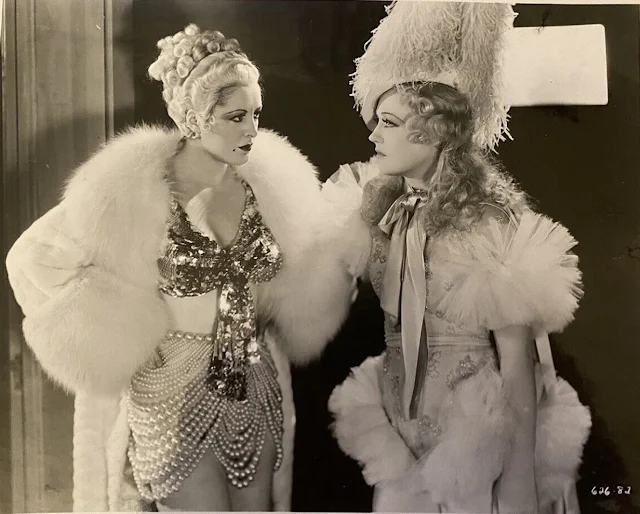 |
| Billie Dove and Marion Davies in Blondie of the Follies |
Cast: Marion Davies, Robert Montgomery, Billie Dove, Jimmy Durante, James Gleason, Zasu Pitts, Sidney Toler, Douglass Dumbrille, Sarah Padden, Louise Carter, Clyde Cook. Screenplay: Frances Marion, Anita Loos. Cinematography: George Barnes. Art direction: Cedric Gibbons. Film editing: George Hively. Music: William Axt.
Marion Davies is always a delight to watch, but Blondie of the Follies is a mess. A sort of backstage, rags-to-riches, romantic comedy with music, it was tailor-made for Davies, who had once been a Ziegfeld Follies chorus girl. In fact, it was where she caught the eye of William Randolph Hearst, But why Hearst would have okayed a story so reflective of his liaison with Davies is something of a mystery, especially since he meddled in the production to make sure it wasn't too close to real life. Not that he was a reluctant meddler: He set up his own production company with MGM for her and made sure that she was photographed and clothed in the most flattering ways possible. Davies is such an adroit comedian, the forerunner of such glamorous funny women as Carole Lombard and Lucille Ball, that she didn't need Hearst's help, especially his desire to see her in serious dramatic roles. There's some drama in Blondie of the Follies, but it's much less entertaining than Davies's clowning, as when she mimics Greta Garbo in a sendup of Grand Hotel (Edmund Goulding, 1932) with Jimmy Durante as John Barrymore. The story isn't much: Blondie McClune (Davies) and Lottie Callahan (Billie Dove) are on-and-off friends and neighbors in a tenement before Lottie runs off to become a Follies girl. Visiting Lottie (now known as Lurline Cavanaugh), Blondie meets Larry Belmont (Robert Montgomery), who has set Lottie/Lurline up in a swank apartment. Blondie decides that the life of a chorus girl isn't so bad after all, and sure enough she follows in Lottie's footsteps, becoming a star and getting set up in her own swell digs by an oilman (Douglass Dumbrille). Moreover, Larry decides that Blondie is more his type than the pretentious Lurline, who is outraged when she finds out. Even though this is a pre-Code movie, there needs to be some indication that the filmmakers don't fully endorse all of this gold-digging and living-in-sin, so Blondie's dad (James Gleason) shows up to disapprove. Finally, he gives in and decides to let Blondie live how she wants to, but not without touching her conscience a bit. Blondie's ambivalence about her lifestyle and her attraction to Larry will be tested, forming what amounts to the plot. There's an interpolated party scene to let Durante do his comic shtick, which hasn't aged well, and a couple of rather clunky production numbers, but they only add to the generally unfocused character of the movie.







_poster.jpg)


